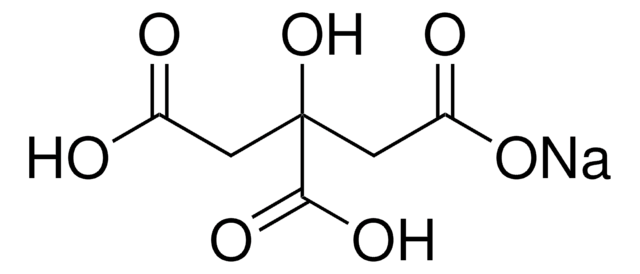71406
Citrato de sodio tribásico dihydrate
purum p.a., ≥99.0% (NT)
Sinónimos:
Citrato de trisodio dihydrate, Ácido cítrico trisodium salt dihydrate
About This Item
Productos recomendados
grado
purum p.a.
Nivel de calidad
Ensayo
≥99.0% (NT)
Formulario
crystals
pH
7.0-9.0 (25 °C, 50 mg/mL in H2O)
mp
>300 °C (lit.)
solubilidad
water: very soluble 24.9 g/L at 20 °C
trazas de anión
chloride (Cl-): ≤50 mg/kg
sulfate (SO42-): ≤50 mg/kg
trazas de catión
Ca: ≤50 mg/kg
Cd: ≤50 mg/kg
Co: ≤50 mg/kg
Cu: ≤50 mg/kg
Fe: ≤50 mg/kg
K: ≤100 mg/kg
Ni: ≤50 mg/kg
Pb: ≤50 mg/kg
Zn: ≤50 mg/kg
cadena SMILES
O.O.[Na+].[Na+].[Na+].OC(CC([O-])=O)(CC([O-])=O)C([O-])=O
InChI
1S/C6H8O7.3Na.2H2O/c7-3(8)1-6(13,5(11)12)2-4(9)10;;;;;/h13H,1-2H2,(H,7,8)(H,9,10)(H,11,12);;;;2*1H2/q;3*+1;;/p-3
Clave InChI
NLJMYIDDQXHKNR-UHFFFAOYSA-K
¿Está buscando productos similares? Visita Guía de comparación de productos
Código de clase de almacenamiento
11 - Combustible Solids
Clase de riesgo para el agua (WGK)
WGK 1
Punto de inflamabilidad (°F)
Not applicable
Punto de inflamabilidad (°C)
Not applicable
Equipo de protección personal
Eyeshields, Gloves, type N95 (US)
Elija entre una de las versiones más recientes:
Certificados de análisis (COA)
¿No ve la versión correcta?
Si necesita una versión concreta, puede buscar un certificado específico por el número de lote.
¿Ya tiene este producto?
Encuentre la documentación para los productos que ha comprado recientemente en la Biblioteca de documentos.
Los clientes también vieron
Nuestro equipo de científicos tiene experiencia en todas las áreas de investigación: Ciencias de la vida, Ciencia de los materiales, Síntesis química, Cromatografía, Analítica y muchas otras.
Póngase en contacto con el Servicio técnico





